Canoe Paddle Strokes
How do you paddle a canoe? There are many ways to move a paddle through the water, check out our favorite paddle strokes for beginners and advanced paddlers, follow the links for more detailed descriptions, videos, and tips on each technique.
Basic Canoe Paddling Strokes
Most of these terms apply both to tandem and solo canoe paddling. For tandem canoes, both people should try to paddle on opposite sides of the canoe – this leads to better stability. Paddling on the same side makes a canoe tippy.
Forward Stroke
Reach as far forward as you comfortably can. Plant the paddle blade fully in the water and pull the blade back towards you alongside the canoe. Voila! The canoe will move forward. Tips: the upper hand is placed on the top of the grip, to push down into the water, and a loose grip will help you avoid fatigue. Use your upper body for power… More Details and Instruction Videos >
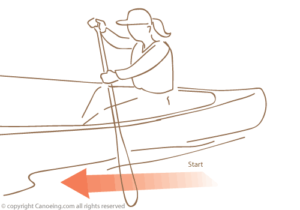
Backwards Stroke
Look out, there’s a rock ahead! Use the back stroke to quickly put the boat in reverse. Simply reach back with both hands and put the paddle in the water to the rear of your body. Then pull forward. Keep the flat side of the blade perpendicular to the canoe. The backward stroke is used to stop the canoe when you already have forward momentum or slow it in moving water. If used by the bow paddler on one side of the boat while the stern paddler uses the forward stroke on the other side, it can be used to pivot the boat.
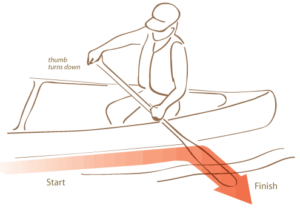 J-Stroke
J-Stroke
Starts the same way as a forward stroke and allows you to gently steer without changing the side you’re paddling on. First, reach as far forward as you comfortably can. Plant the paddle blade fully in the water and pull the blade back towards you alongside the canoe, it will move forward. Now turn your wrist to make a J. At the end of your stroke, turn the wrist of your near-hand outward, so the paddle blade makes an imaginary J away from the canoe. This will pull the front tip of your boat back in line and keep it moving straight… More Details and Instruction Videos >
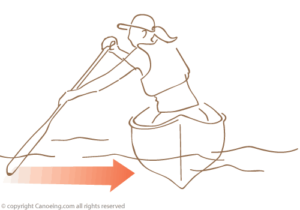 Draw Stroke
Draw Stroke
Handy when you need to move the canoe sideways or when you’re pulling up to a dock. Reach out as far as possible with the lower hand and place paddle in the water. Pull your shaft hand inward, this creates leverage and moves the canoe in the direction of your paddling side.
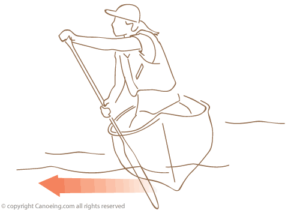 Pry Stroke
Pry Stroke
The opposite of the draw stroke — it pushes the canoe away from the paddling side. Put the paddle in the water parallel and as close to the canoe as possible. Hold the paddle out with your grip hand as far over the water as you can reach, tilt the blade so its almost underneath the boat, then pull in with the grip hand while pushing out with the shaft hand to ‘pry’ the boat.
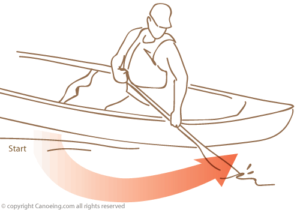
Sweep Strokes
A sweep stroke looks just like it sounds – you sweep the paddle blade in an arc, pushing the water turns the canoe. Keep the paddle relatively horizontal. Try different arcs to see how rapidly the canoe will turn. More Details and Instruction Videos >
Solo Canoe Paddling Strokes
Solo canoe paddlers usually sit in the center of a canoe, often kneeling in the bottom, this puts the center of gravity at the lowest point possible and makes a solo canoe more stable.
C-Stroke
Begin the stroke like a draw, then arc the paddle inward almost under the canoe. Finish with a slight burst outward, as with the J-stroke.
Sculling Draw
Used to move a canoe sideways in shallow water or for a solo paddling. Place the paddle in the water about two feet in front of you, rotate the leading edge of the blade away from the canoe and pull backward. At the end of the stroke, roate teh blade again and push the water forward. The canoe will move toward your paddle. This stroke makes a figure-8 in the water, yet keeps the paddle blade nearly parallel to the canoe. Video: Becky Mason shows the advanced Sculling Draw >
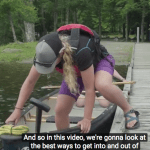
How to Safely Get in a Canoe
Tip: Do not push pull or drag a canoe on the ground. Walk it into the water and avoid damage to the bottom of the boat. For tandem canoeing, the stern paddler stabilizes the canoe while the bow paddler climbs in and moves to the front, keeping center of gravity low… Video: How to get in a canoe safely and smoothly >
SOURCES AND RESOURCES
Basic Illustrated Canoe Paddling
Basic Essentials Canoeing by Cliff Jacobson
Outdoors.org – Five Essential Paddle Strokes
Scouting Magazine – Different Paddle Strokes for Canoeing Folks
Find More Canoeing How-to in the Beginner’s Guide >



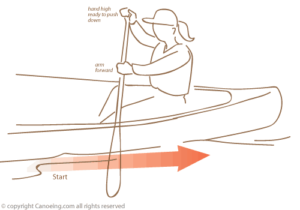

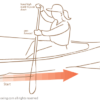









I have a paddle stroke that is not mentioned anywhere I can find, likely others use it but I started on my own so sort of invented it. I call it the Tofino Roll, but its like a O stroke. It starts out as a typical J stroke but at the end of the J you continue rolling the paddle (requires you to let the top go in your top hand and let it turn on your palm) So you return the paddle thru the air rolling it so that the second stroke is going to be pulling water on the opposite side of the paddle as the first time. You need a non directional paddle for this (most are). I have a video if you want to see it email me.. John Enns